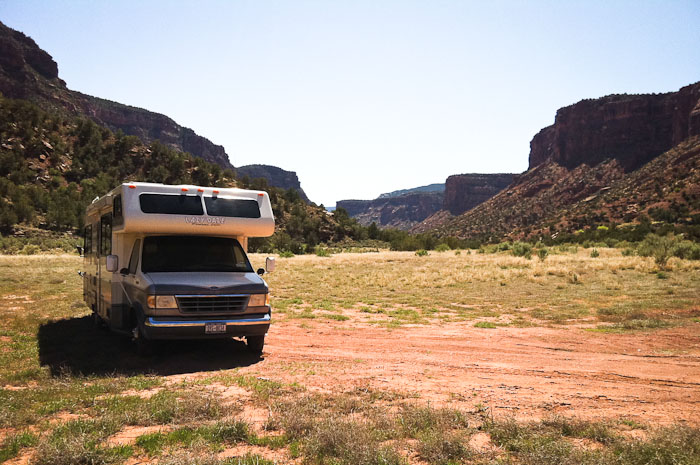Sewemup Mesa Canyon, Gateway CO

Boondocked below Sewemup Mesa, Gateway CO, April 28, 2011
Point of Interest
From the roadside POI sign along Rt-141 10 miles south of Gateway CO:
Sewemup Mesa is one of the ecologically pristine areas in western Colorado, having been isolated from development by its almost impassible belt of encircling sandstone cliffs. A striking band of thousand-foot-high cliffs of Wingate Sandstone encircles more than 75% of Sewemup Mesa. Many huge ponderosa pines line the canyons of the mesa top and grow directly from sandstone terraces along the mesa's western cliffs. The cliffs provide nesting sites for the endangered peregrine falcon, as well as for the golden eagles. Bald eagles winter along the Dolores River at the area's edge. Mountain lions rule the mesa, and the lower slopes are important big-game winter range for deer and elk.
The legend of Sewemup Mesa began in the late 1800's as a real true cattle-rustling operation. A local rancher "rustler" would drive stolen cattle, from both Utah and Colorado up into the well concealed "pockets" of the mesa. There he would rope them, tie them down and with a sharp knife, cut out the piece of the hide containing the brand. He would then sew them back up with bailing [sic] wire and rawhide. After the wounds healed, the cows would be branded with the rustler's own brand. Then they would be put back on the range with the other cattle and no one was any wiser.
Sewemup Mesa Canyon is a limited, rough, but picturesque boondocking site along the BLM primitive road into the canyon below Sewemup Mesa, a half mile off CO Rt 141 about 10 miles south of Gateway CO.
Sewemup Mesa Canyon, Gateway CO
- Verizon cell phone and EVDO service - no signal
- Locate Sewemup Mesa Canyon on my Night Camps map
- Check the weather here
Nights I've camped here
It's Time to Go Home
The truth about nature is that she is inside us, all around us, just waiting for us to ask her what to do. The truth about civilization is that it was an honest mistake, an invention that was necessary at the time, a mere 30,000 years ago, when nature appeared to be letting us down and we thought we could do better. But now it has outlived its usefulness, and is out of control, and threatens the survival of all life on our planet, so it's time to let it go. It's time to move forward and imagine and invent a new culture, a sustainable one that works for all creatures on Earth, drawing on the best learnings from nature and the best innovations from civilization.
It's time to go home.